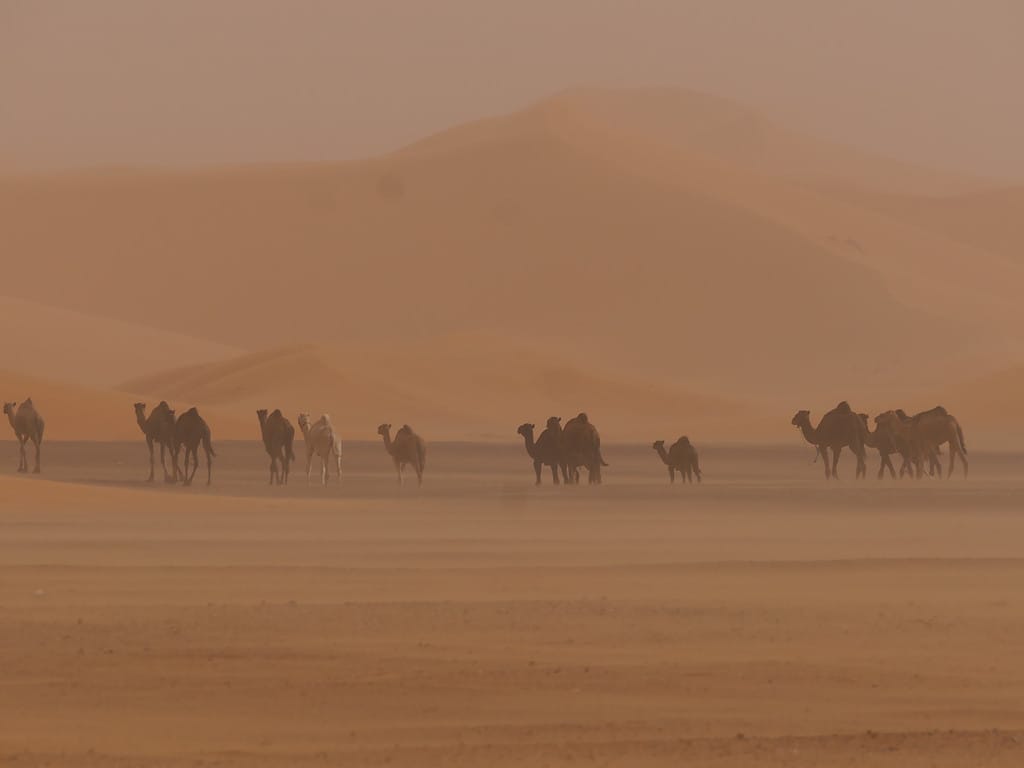The Sahara Desert spans the continent of North Africa from the Atlantic Ocean in the west to the Red Sea in the east and the Mediterranean Sea to the north across an area of 3,600,000 mi2, it is the largest hot desert in the world. The region incorporates 10 countries including Tunisia, Sudan, Western Sahara, Niger, Mauritania, Mali, Libya, Egypt, Chad, and Algeria. In Arabic, Sahara means “the greatest desert.” Read on to find out more about “Snow in the Sahara Desert: Discover where it snows and how often.”
The Sahara Desert Climate

Dunes cover about 25 percent of the Sahara.
©MrLis/Shutterstock.com
Dunes, rocky barren plateaus, salt flats, mountains, and dry valleys make up the Saharan climate, therefore, there is very little rainfall. Specifically, less than one inch annually. The Atlas Mountain range is to the west and on the southern border is the Niger River and the Shael a semi-arid savannah. Dunes cover about 25 percent of the Sahara, but there are also a few mountain ranges and grasslands. Sand seas, or ergs, produce constant movement of the sand caused by the area’s high winds.
The only constantly flowing river here is the Nile River, other water sources come and go or are subterranean. However, where there is water there are settlements and towns. In fact, in these inhabited areas grasslands, trees, and shrubs grow where the soil is fertile providing excellent crops. In the Saharan Desert, the highest peak is in Chad; the Emi Koussi is a volcanic peak in the Tibesti Mountains reaching over 11,300 feet above sea level. On the other hand, Egypt’s Qatarra Depression is 436 feet below sea level.
Snow in the Sahara Desert: Discover Where It Snows and How Often

Occasionally there is snow in the Atlas Mountains.
©Todamo/Shutterstock.com
The recipe for snow is moist air and cold temperatures, these exist in some parts of the Sahara. Winter air circulation draws moist, cool air toward the northern parts of the Sahara from the Mediterranean and Atlantic. On higher ground such as in the Atlas Mountains in Algeria and Morocco, the rising air can form snow crystals and produce snowfall. Indeed, there is snow in the Sahara Desert, but it falls on higher ground and infrequently.
In Algeria, the winters of 1979, 2016-2018, 2021, and 2022 in the town of Aïn Séfra reported snow. This town in the Atlas Mountains is located at over 3,200 feet above sea level. Reports say the last measurable snow fell in Aïn Séfra in 1979 with the snowstorm lasting for about 30 minutes and snow remained for a day before melting on the sand. Additionally, on January 24th, 2023 snow was reported on the mountaintops of Bèchar Province of Algeria.
Typical Weather

The Sirocco is a strong wind that originates in the Sahara.
©Yvan Tessier/iStock via Getty Images
The hottest recorded temperature in the Sahara is 136 degrees Fahrenheit or 58 degrees Celsius. Average temperatures are 86 degrees Fahrenheit or 30 degrees Celsius. The air here has very little humidity to hold the heat so the nights are often below freezing. Even more, the Sirocco is a strong wind that originates here and can get to up to as much as 62 miles per hour. Storms are sometimes seen from space!
Flora and Fauna

The Saharan
cheetah
survives the harsh desert environment.
©Wayne Marinovich/Shutterstock.com
Plant Life
Due to the harsh condition’s here plants are sparse. However, there are about 500 plant species. Palms, spiny shrubs, grass, and acacia trees, for example, have adapted to the hot and dry climate. Plants that grow close to the ground can avoid water loss in the strong Saharan winds. Coastal areas of the Atlantic grow shrubs, succulents, and lichens. The Jebel Unweinat Mountains and the Tibesi Mountains, where there is more rain and lower temperatures, have plant life that includes palms, acacias, oleander, myrtle, and tamarix.
Animal Life
Nearly 70 species of animals live in the Sahara because they can survive for long periods without drinking water. These hardy creatures include Dorcas gazelle, Saharan cheetah, African wild dog, pale fox, and fennec fox. One amazing animal here is the addax, for example, which can survive for a year without water. Some other species that call this home include scorpions, snakes, and lizards. In addition, crocodiles are found in Chad and Mauritania. Birds in the Sahara include the black-throated Firefinch and the African silverbill. Local Berbers are known to domesticate goats and camels.
In Conclusion
Amazing as it seems, even in the hottest desert on earth there is the occasional snowfall. The Saharan desert is a unique place filled with incredible beauty from its stark dunes to its mountain peaks.
The photo featured at the top of this post is © Michael Kerling from Berlin via Wikimedia Commons – License / Original
Thank you for reading! Have some feedback for us? Contact the AZ Animals editorial team.







